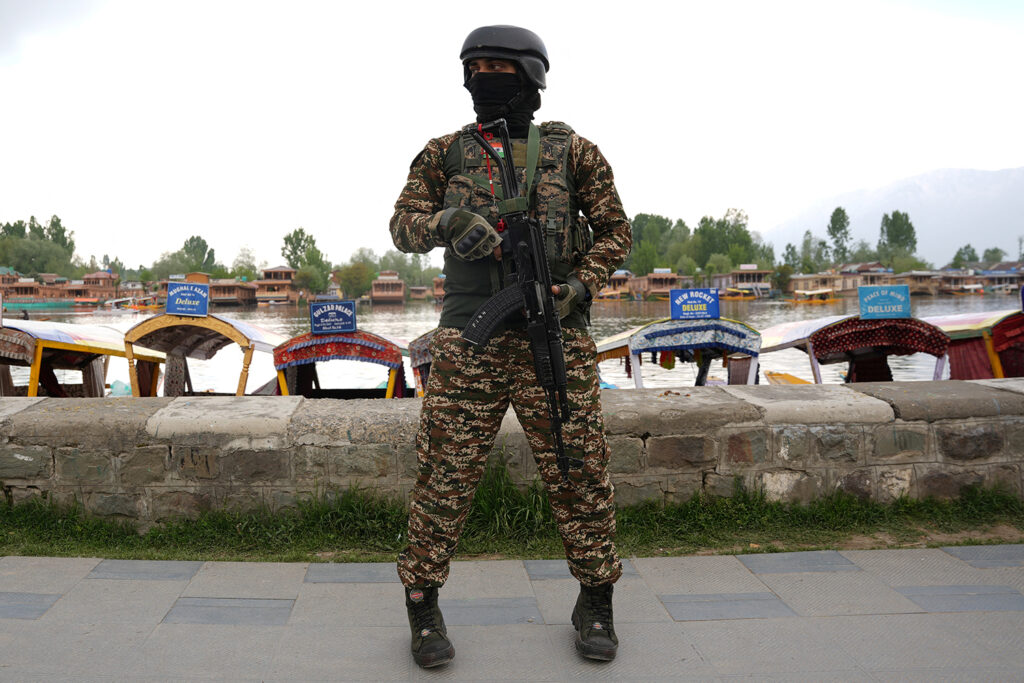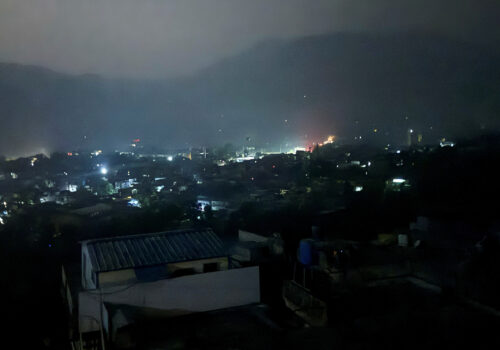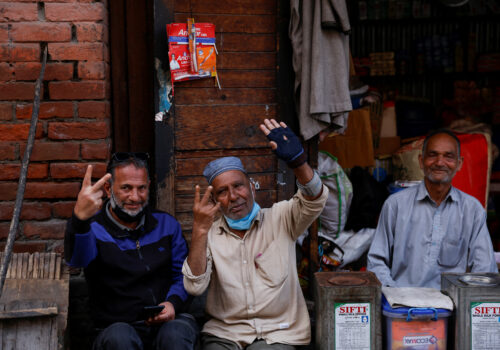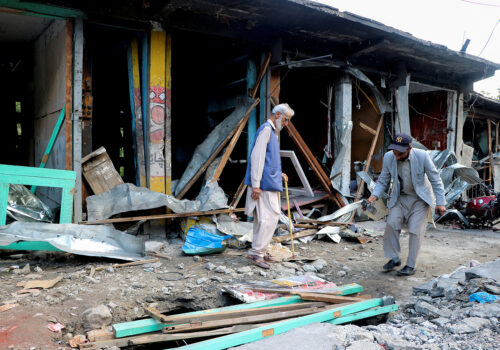The recent headline-grabbing flare-up between India and Pakistan over Kashmir was punctuated by missile strikes, one of the fiercest aerial dogfights since World War II, retaliatory rhetoric, and a shaky cease-fire. But there’s a quieter, yet equally consequential, shift worth watching closely: one taking place among India and Pakistan’s neighbors.
These neighbors are Bangladesh, Sri Lanka, Nepal, Bhutan, and the Maldives, none of which has nuclear weapons. They are not simply bystanders to the crisis. They are strategic actors who may now look to recalibrate their foreign policies in response to the conflict’s regional aftershocks. These are the “swing states,” and they deserve far more attention before the next escalatory episode in the India-Pakistan conflict.
India-Pakistan crises have long been treated as isolated bilateral dramas, bracketed by historical grievance and nuclear deterrence. However, each episode, whether Balakot in 2019 or the present-day Kashmir escalation, creates cascading effects that test the diplomatic, economic, and strategic footing of the region’s smaller, nonnuclear states. This time, the stakes are especially high, as these “swing states” must increasingly calibrate their strategic hedging efforts with China, which is now a central part of the geopolitical equation.
Bangladesh: From alignment to ambiguity
Bangladesh finds itself in the most precarious position. Following the fall of Sheikh Hasina’s pro-India Awami League government in August 2024, along with the rise of a transitional administration, the country is navigating both internal fragility and external recalibration.
Civil-society actors, nationalist voices, and Islamist groups are converging around a shared skepticism of what they see as New Delhi’s interference in Bangladesh’s internal politics—especially given India’s role in sheltering Hasina and maintaining support for the Awami League. Hasina’s party was recently banned by Bangladesh under the country’s anti-terror laws, following a United Nations report that accused the former government of engaging in human rights violations, from extrajudicial killings to arbitrary arrests; the report also said that as many as 1,400 protesters were killed at the hands of military firearms.
As anti-India sentiment intensifies, Dhaka may feel compelled to reassert a more independent or even oppositional posture. India has heightened security measures around the Siliguri Corridor (called the “Chicken’s Neck”), a critical link to its northeastern states, amid Bangladesh’s deepening ties with China and its reported agreement to a recent United Nations proposal for a humanitarian-aid corridor into Burma’s Rakhine State. Although framed as a humanitarian initiative, Indian analysts interpret this move as part of a broader trend of external encroachment in India’s strategic backyard.
This is particularly volatile timing for India. It faces a Bangladesh that may lean harder into diversifying its infrastructure via China, renewing engagement with Pakistan, and framing neutrality as sovereignty. Bangladesh has accused India of pushing at least 260 people—including undocumented migrants and Rohingyas—into Bangladesh since last week. Observing India’s unilateral approach to Pakistan, the interim government in Dhaka may seek to quickly acquire Chinese weapons and defense systems.
In the long run, a Bangladesh reasserting its strategic autonomy, via diversified partnerships and “soft balancing,” could fundamentally shift the Bay of Bengal’s strategic geometry, especially given Bangladesh’s location next to Burma.
Sri Lanka: Fragile coalitions and minority resonance
In Sri Lanka, the Kashmir crisis reverberates through the dual pressures of domestic fragility and regional recalibration. Still recovering from economic collapse and navigating reforms required by its deal with the International Monetary Fund, Colombo has limited bandwidth for overt foreign alignment. Yet India’s assertiveness during moments of crisis, such as its tightening of security partnerships and its invocation of counterterrorism narratives, puts pressure on Sri Lanka to demonstrate loyalty to its northern neighbor.
At the same time, China remains deeply embedded in Sri Lanka’s economic fabric, from the Hambantota Port to Port City Colombo. Indian policymakers may expect regional solidarity, but for Sri Lanka, overcommitting to India could jeopardize its strategic balancing act. Maintaining maneuverability between India and China is not just a diplomatic preference but also a form of strategic hedging critical for economic recovery and political stability.
Layered onto this is the domestic sensitivity of Sri Lanka’s Muslim population, which remains attuned to regional narratives of anti-Muslim sentiment. India’s ruling Bharatiya Janata Party (BJP) leads a Hindu-nationalist agenda. The BJP also has ties to a Hindu-nationalist organization called the Rashtriya Swayamsevak Sangh (RSS), with most in India’s cabinet, and Modi himself, current or former members of RSS. According to the leader of the Sri Lankan Sinhalese-Buddhist nationalist group Bodu Bala Sena, the group had discussed the possibility of forming a “Hindu-Buddhist peace zone” with RSS to counter what they frame as Islamic extremism in South Asia (although RSS denied this claim). This growing alignment between Buddhist and Hindu nationalist actors contributes to a perception among the Muslim community that exclusionary majoritarianism is regionally coordinated. In this context, overt alignment with a Hindu-nationalist India during a Kashmir crisis could inflame domestic tensions, further narrowing Colombo’s already limited strategic space.
Nepal: Blockade memories and the limits of neutrality
Nepal has long pursued a balancing act between India and China, using subregional frameworks such as the Bangladesh, Bhutan, India, Nepal Motor Vehicles Agreement and Belt and Road Initiative rail diplomacy to diversify its dependencies. Yet, heightened Indian security sensitivities during periods of crisis make this balancing act harder to sustain. Kathmandu knows too well what happens when it asserts too much sovereignty: In 2015, Nepal adopted a new constitution over Indian objections, refusing to amend provisions that New Delhi viewed as not inclusive of concerns held by the Madhesi populations—ethnic groups with strong ties to India. This was followed by a months-long blockade at key border points, which, while officially denied by India, was widely perceived in Nepal as Indian coercion. That perception was not unfounded—India had previously imposed an official economic blockade on Nepal in 1989 in part in response to arms purchases from China. The 2015 blockade triggered widespread fuel and medicine shortages and ignited a surge in anti-India nationalist sentiment across Nepal. More recently, India and Nepal have been locked in a cartographic dispute, following India’s 2019 release of a new political map that included contested territory. That move provoked diplomatic escalation and led the Nepalese parliament to publish its own revised map—an assertive gesture of sovereignty.
In moments of India-Pakistan escalation, Kathmandu’s efforts to remain equidistant may be recast as disloyalty by New Delhi. With its foreign policy under scrutiny and nationalism rising at home, Nepal may face a shrinking space for strategic hedging. The ambiguity that once gave it leverage, such as balancing infrastructure deals, cross-border trade, and diplomatic signaling, may now be a liability in an increasingly polarized regional environment.
Bhutan: Quiet hedging in a noisy region
Bhutan is expected to remain aligned with India, given their close historical, economic, and security ties, with the countries having signed a Treaty of Friendship in 1949. Yet, Indian military distraction on the western front creates a vacuum of attention in the north, where Chinese territorial pressure has grown steadily. That has particularly been the case since the Doklam standoff in 2017, when Indian and Chinese troops engaged in a seventy-three-day face-off over a road China was constructing in a strategically sensitive area near the trijunction of India, China, and Bhutan—in territory claimed by both China and Bhutan and considered vital to India’s security posture in the northeast.
While Thimphu’s foreign policy appears cautious, the reality is more complex. Bhutan practices hedging of a different kind, where it defines its international posture through minimalist diplomacy and self-protective slowness, rather than binary choices.
While crises like Kashmir do not dramatically alter Bhutan’s foreign policy, they add pressure on Thimphu to quietly reassess its strategic environment, particularly as India’s regional bandwidth narrows and Chinese overtures in the north continue to intensify.
Maldives: Between militarization and backlash
In the Maldives, the Kashmir flare-up may rekindle anti-India backlash among Islamist and conservative political groups, just as New Delhi is looking to deepen its naval presence in the Indian Ocean. The president of the Maldives, Mohamed Muizzu, won the 2023 election with an “India Out” campaign, which framed Indian military presence on the archipelago as an infringement of Maldivian sovereignty. Muizzu has since moved to recalibrate the country’s foreign policy orientation, including by asking Indian troops to pull out from his island nation. Even though the Maldivian president has recently softened his stance with his trip to India, political figures, particularly those aligned with conservative groups, may now seize on the conflict in Kashmir to amplify anti-India sentiment, framing the crisis as part of a broader campaign against Muslims, who form the majority in the Maldives.
At the same time, Malé’s close economic ties to China and development partnerships with India put it in a bind. The country’s hedging strategy, balancing regional power interests while cultivating leadership on climate security, relies on maintaining diplomatic maneuverability. The India-Pakistan conflict narrows that space.
Strategic hedging, under pressure
What ties these disparate responses together is a common strategy: Hedging. These five “swing states” have, in recent years, mastered the art of calibrated ambiguity. They seek economic gain from and security cooperation with multiple powers—India, China, and the United States—without being drawn into hard alliances. This allows them to maximize autonomy and avoid capture, whether through aid dependency, military pressure, or infrastructure entanglements.
Yet, India-Pakistan crises stress test this architecture. Each episode forces these “swing states” to signal their preferences, take rhetorical positions, or manage public backlash, which is often at the expense of their preferred strategy of quiet recalibration.
Washington must take note
The United States increasingly views India as a pillar of its Indo-Pacific strategy, but India’s regional leadership is only as strong as its relationships with its neighbors. A South Asia in which every India-Pakistan skirmish pushes the “swing states” toward anti-India sentiment or deeper engagement with China is a region less stable—unfavorable for US interests.
At the same time, the United States continues to prioritize maritime-centric approaches and groupings such as the Quad in its Indo-Pacific strategy, focusing primarily on the Chinese threat to maritime stability. While it does so, it is sidelining the very terrain where regional contestation is already unfolding: in continental South Asia. Such contestation has taken place over land connectivity, subregional diplomacy, maritime security, and crisis responses among the five nonnuclear countries.
If Washington wants to invest in long-term regional stability in South Asia, it must understand not only the loud actors, but also the quiet strategists—the five “swing states.” Ignoring their pivotal roles risks ceding ground to rival powers and destabilizing South Asia’s fragile geopolitical balance, with consequences far beyond the subcontinent.
Rudabeh Shahid is a nonresident senior fellow at the Atlantic Council’s South Asia Center.
Nazmus Sakib is a lecturer in the Lewis Honors College at the University of Kentucky.
Further reading
Tue, May 6, 2025
Experts react: India just launched airstrikes against Pakistan. What’s next?
New Atlanticist By
Atlantic Council experts share insights on India's missile strikes on Pakistan, which came two weeks after a terrorist attack targeting Indians in Pahalgam.
Sat, May 10, 2025
Experts react: India and Pakistan have agreed to a shaky cease-fire. Where does the region go from here?
New Atlanticist By
With the fog of war still hovering over South Asia, Atlantic Council experts explore what's to come.
Mon, May 12, 2025
The India-Pakistan crisis shows Washington that it must stop Iran’s nuclear rise
New Atlanticist By Alex Plitsas
The fighting in South Asia reminded Washington of the global stakes of nuclear crises. Those stakes are why the United States must prevent Iran from developing nuclear weapons.
Image: An Indian security force personnel stands guard on the banks of Dal Lake, following a suspected militant attack near south Kashmir's Pahalgam, in Srinagar April 23, 2025. Photo via REUTERS/Sanna Irshad Mattoo.




